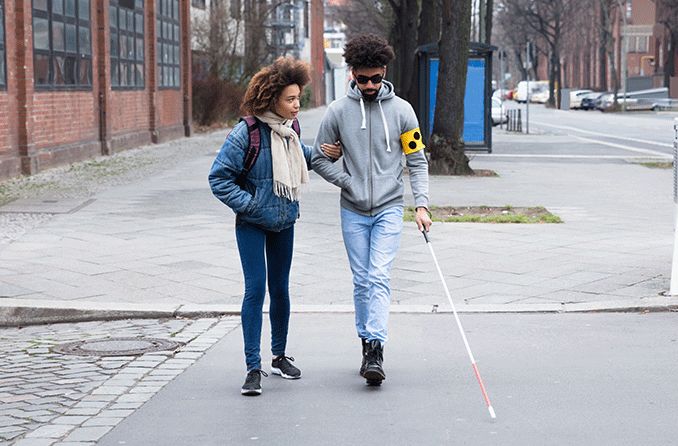How to help someone who is visually impaired

Good vision is a precious gift — and one that's easy to take for granted.
Imagine for a minute what life would be like if your vision was permanently impaired and could not be corrected with eyeglasses, contact lenses or vision surgery. This is the situation many people find themselves in every day, suffering from what's called "low vision."

There are many ways to help someone with vision loss. You can take them shopping, do home repairs, or just hang out and be a friend.
Other terms often used to describe people with low vision are "partially sighted," "visually impaired" and "legally blind."
Causes of low vision include hereditary conditions, eye injuries and eye diseases such as glaucoma and macular degeneration. Whatever the origin, low vision often causes depression and feelings of isolation and helplessness. [Read our article on how depression changes your vision.]
How You Can Help
If you have a friend or family member with low vision or know others in your community who are partially sighted, here are a few ways you can help them maintain their independence and get the most out of their remaining eyesight:
Help them learn about low vision aids. Special optical devices called low vision aids often can enable people to use their remaining vision more effectively and do things they thought were no longer possible.
These devices include customized magnifiers for reading and other near tasks, computerized text-to-speech devices and handheld or spectacle-mounted telescopes for seeing objects in the distance. Many are covered by health insurance.
You can help by arranging a visit to their eye care practitioner to learn which optical aids will provide the most benefit. (If the practitioner doesn't usually work in low vision, he or she may recommend a low vision specialist in the area.)
A low vision exam is different from a regular eye exam and typically involves follow-up visits to help the person with low vision use the prescribed vision aids effectively.
The practitioner also might suggest non-optical aids to help someone with low vision enjoy life more fully. Examples include audio books, large-print books and other large-print items, such as playing cards, clocks, phones and pillboxes.
READ NEXT: How to prepare your visually impaired child to start school
Low Vision News

The Most Common Problems For People With Low Vision
Trouble reading is the most commonly reported problem of people with low vision, regardless of the underlying cause of their vision loss, according to a study.
The Low Vision Rehabilitation Outcomes Study recruited 819 patients seeking low vision services at 28 clinical centers in the United States. Before their appointment, new patients were asked, "What are your chief complaints about your vision?"
Difficulty reading was the most common complaint, reported by 66.4 percent of patients. Other functional difficulties included driving (27.8 percent), using magnifiers and other vision aids (17.5 percent), mobility (16.3 percent), performing normal in-home activities (15.1 percent), problems associated with lighting and glare (11.7 percent), and trouble recognizing faces and engaging socially (10.3 percent).
The likelihood of reading difficulties increased mildly with age but did not differ significantly with changes in visual acuity. Women were more likely to report difficulty with in-home activities, facial recognition and social interactions, whereas men were more likely to report trouble driving and difficulties related to lighting. Mobility concerns, defined as difficulty walking and performing away-from-home activities, showed no relationship to gender, age or visual acuity.
The study authors concluded that since difficulty reading was the most common complaint, reading rehabilitation should be a cornerstone of low vision care. — G.H.
READ NEXT: How to create a home that accommodates visual impairment and blindness
Give them a hand and light up their life. A few easy adjustments to the living areas of a person with low vision can improve visibility and reduce the risk of a fall:
Make sure their home is well lit, with high-wattage light bulbs and additional lamps or task lighting. The kitchen, bathroom and work areas all should be fully and evenly illuminated.
Remove unnecessary household clutter. Offer to help with organizing important items and packing up others.
Create a list of important phone numbers in large print on bold-lined paper. Include doctors, transportation and emergency contacts, and put the list in a convenient place.
Mark stairs or slopes with brightly colored tape. Eye-catching colors that contrast with the flooring work best.
Suggest purchasing a large-screen television that produces high-contrast images.
SEE RELATED: How to Get a Guide Dog
Low Vision News

Want To "Be My Eyes"? This App Lets You Help A Blind Person See
Be My Eyes is an app that connects blind people with sighted helpers to solve quick problems such as reading labels or expiration dates on food or navigating a street.
Through smartphones the blind person shows the sighted helper the scene, so the two can work together to solve the problem the blind person is coping with at the moment.
A Danish furniture craftsman named Hans Jorgen Wiberg, who began losing his vision at age 25, came up with the idea of Be My Eyes.
You can give the app a try by downloading it from the iTunes store. — L.S.
READ MORE: How to make the internet easier to navigate with impaired vision
Be a shopping buddy. Getting out of the house can help lift the spirits of a person with low vision. If their vision is not good enough to drive, offer to take them grocery shopping once a week.
Make a shopping list ahead of time, and help them locate items on the store shelves. Encourage them to do as much of the shopping task as they can on their own, but be close by to help when needed.
Travel tips. Help the person with low vision learn about all transportation services that are available, including those provided by local churches and community groups. Encourage them to ask questions and speak up if they are traveling alone and need assistance.
When walking with someone with impaired vision, try to walk a few steps ahead, at a pace that is slower than usual. This way, the individual can anticipate the terrain based on your cues. Alert them to steps, curbs and other potential problems you are approaching that might be difficult to see. [Read our article on tactile paving.]
Learn as much as you can about the particular vision issues they have. For example, people with advanced glaucoma usually have difficulty with side vision. Knowing this will help you to anticipate mobility problems when the two of you are out and about.
READ MORE: Yes, you can travel if you’re blind or have low vision
Characterizing functional complaints in patients seeking outpatient low-vision services in the United States. Ophthalmology. August 2014.
Page published on Wednesday, February 27, 2019






